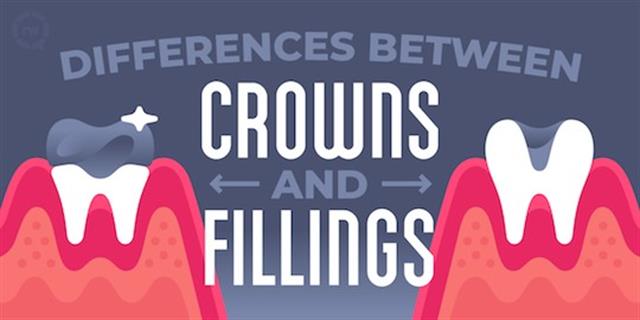Your cart is currently empty!
Dental Crown vs. Filling: How to Choose the Best Option for Your Teeth

When dealing with tooth decay or damage, choosing between a dental crown and a filling can be confusing. Both serve to restore your tooth’s health and appearance, but they differ in how they’re applied, how long they last, and their overall cost. Understanding these differences is key to making the right decision for your oral health and achieving lasting results.
This guide breaks down the differences between dental crowns and fillings—covering their types, benefits and drawbacks, cost considerations, and how to decide which option is right for you. We also discuss how your dentist can help you choose the best treatment.
What Are Dental Crowns and Fillings?
A dental crown is a tooth-shaped cap placed over a damaged tooth to restore its shape, size, strength, and appearance. It completely covers the visible part of the tooth and is usually recommended for teeth that are cracked, heavily decayed, or weakened. Crowns can be made from porcelain, ceramic, metal, or a combination of materials.
A dental filling, on the other hand, is used to fill small to moderate cavities caused by tooth decay. The process involves removing the decayed part of the tooth, cleaning the area, and filling it with materials like composite resin, amalgam, gold, or porcelain. Fillings are ideal for minor repairs and are less invasive than crowns.
Key Differences: Dental Crowns vs. Fillings
While both treatments aim to restore function and appearance, they differ in several important ways:
- Application: Fillings are used for minor decay and typically require one visit. Crowns are suited for more serious damage and usually take two visits.
- Durability: Crowns tend to last longer than fillings. Fillings can last 7–20 years, while crowns often last 10–15 years or more with proper care.
- Protection: Crowns cover and protect the entire tooth, offering more support. Fillings only repair the cavity and provide limited structural reinforcement.
Types of Dental Crowns and Fillings
Different types of crowns and fillings are available, each with its own advantages depending on your dental needs:
Types of Dental Crowns
- Metal Crowns: Highly durable and ideal for molars, though less aesthetic.
- Porcelain-Fused-to-Metal (PFM): Offers a natural look with added strength but may chip over time.
- Pressed Ceramic: Strong core with a tooth-like appearance, but can still chip.
- All-Resin Crowns: Economical but more prone to wear and usually used temporarily.
Types of Dental Fillings
- Composite Resin: Tooth-colored and aesthetically pleasing.
- Amalgam: Durable and cost-effective, best for back teeth.
- Gold: Long-lasting but expensive and noticeable.
- Porcelain (Inlays/Onlays): Custom-made for strength and aesthetics.
Pros and Cons: Crowns vs. Fillings
Understanding the benefits and limitations of each option can help you make a confident decision:
Pros of Dental Crowns
- Strong protection for severely damaged teeth
- Long-lasting durability
- Improves tooth appearance
Cons of Dental Crowns
- More tooth structure must be removed
- Higher cost than fillings
- Requires multiple dental visits
Pros of Dental Fillings
- Preserves more of your natural tooth
- Less expensive and quicker procedure
- Ideal for small to moderate cavities
Cons of Dental Fillings
- Not as durable as crowns
- May not work for large or deep cavities
- Can wear out or fall out over time
Crown vs. Permanent Filling After Root Canal
For teeth that have undergone root canal therapy, crowns are typically more effective due to the strength and full-coverage protection they provide. While fillings may work for small cavities post-treatment, crowns offer longer-lasting protection for weakened teeth.
Cost Comparison: Crown or Filling?
Crowns are generally more expensive due to their complexity and material cost. Fillings are more affordable upfront but may not last as long, especially for larger repairs. Over time, a crown might be more cost-effective for severely damaged teeth, offering greater protection and longevity.
What to Consider When Choosing
When deciding between a crown and a filling, keep the following in mind:
- Extent of Damage: Crowns are better for severely damaged or decayed teeth.
- Tooth Location: For front teeth, aesthetics may matter more; porcelain or ceramic crowns may be ideal. For back teeth, durability is key.
- Budget and Insurance: Understand what your insurance covers and compare costs.
- Longevity: Consider how long you want the solution to last and whether you’re willing to invest in a more permanent fix.
Why Professional Guidance Matters
Ultimately, the best way to determine the right treatment is to consult a dental professional. A dentist will assess the condition of your teeth, review your oral health history, and recommend a personalized solution. Routine checkups can also help catch issues early and avoid more intensive procedures later.
FAQs
Q: Which option looks better cosmetically?
A: Crowns offer a more natural look, especially when matched to your tooth color.
Q: How long do crowns and fillings last?
A: Fillings last about 10 years on average, while crowns can last 10–15 years or more.
Q: Is the procedure painful?
A: No, both procedures are done under local anesthesia and are generally painless.
Q: Can a crown go over a filled tooth?
A: Yes, a crown can be placed over a tooth with a large filling to add strength and protection.
Q: How do I choose between the two?
A: Your dentist will evaluate your tooth’s condition and help you choose the most effective option.
About the author
Leave a Reply